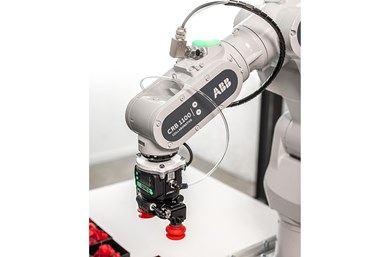ABB Expands Portfolio with Stronger, Faster, More Capable Cobots
Appears in Print as: 'Cobots Provide Stronger, Faster, More Capable Automation'
These cobots are designed to be easy to use and configure, thereby expanding automation into a variety of high-growth industries.
Edited by Angela Osborne

ABB SWIFTI cobot
ABB is expanding its collaborative robot (cobot) portfolio with the GoFa and SWIFTI cobot families, offering higher payloads and speeds. The company says these are stronger, faster and more capable cobots designed to expand automation in high-growth segments, including electronics, health care, consumer goods and logistics as well as food and beverage.
GoFa and SWIFTI are intuitively designed so there’s no need to rely on in-house programming specialists. Industries with low levels of automation will be able to operate their cobot within minutes of installation, straight out of the box, with no specialized training, the company says.
According to the company, these cobot lines have the potential to transform workplaces and help users achieve new levels of operational performance and growth. They are easy to use and configure, and backed by ABB’s global network of on-call, online service experts to enable businesses of all sizes and sectors of the economy to utilize robots for the first time.
The cobots are designed to operate in the presence of workers without the need for physical safety measures such as fences, and to be very easy to use and install. GoFa and SWIFTI cobots are engineered to help businesses automate processes to assist workers with a variety of tasks, including material handling, machine tending, component assembly and packaging in manufacturing, medical laboratories, logistics hubs and warehouses, workshops and small production facilities.
Users comfortable with operating a tablet or smartphone will be able to program and reprogram the cobots with ease using ABB’s fast setup tools, the company says. Every ABB cobot installation includes a startup package that provides ABB Ability condition monitoring and diagnostics as well as a free support hotline for the first six months to access ABB’s expert technical assistance.
RELATED CONTENT
-
Handling Parts In A Robotic Cell
Here’s a review of the workholding and workhandling challenges a shop faces as it moves a part through a robotic cell, from serving up the blanks to the transfer of the final workpiece to post processing and gaging. Productivity, Inc. takes the reader through a few of their cells that they've installed using Fanuc robots and a variety of other machine tool equipment.
-
Bar Feeder Basics
Some primary factors are often overlooked when considering how to justify the implementation of a bar feeder for turning operations.
-
Choosing an Automatic Bar Feeder
The bar feeder is the most common form of automation for turning operations. Selecting the right one requires consideration of the applications for which it will be used.



